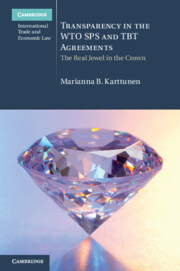Book contents
- Transparency in the WTO SPS and TBT Agreements
- Cambridge International Trade and Economic Law
- Transparency in the WTO SPS and TBT Agreements
- Copyright page
- Dedication
- Contents
- Figures
- Tables
- Foreword
- Acknowledgements
- Abbreviations
- Table of Cases
- Country Classification
- Introduction
- Part I Why the SPS and TBT Agreements?
- PART II Transparency as a Substitute for Dispute Settlement
- Part III Transparency as a Complement to Dispute Settlement
- 6 Transparency and Disputes
- 7 Climbing the WTO Disputing Pyramid
- 8 Access to the WTO Disputing Pyramid
- 9 Is the Current Interaction between Transparency and Dispute Settlement the Best It Can Be?
- Conclusion of Part III
- Conclusion
- Appendices
- References
- Index
6 - Transparency and Disputes
Where Is the Difference?
from Part III - Transparency as a Complement to Dispute Settlement
Published online by Cambridge University Press: 28 April 2020
- Transparency in the WTO SPS and TBT Agreements
- Cambridge International Trade and Economic Law
- Transparency in the WTO SPS and TBT Agreements
- Copyright page
- Dedication
- Contents
- Figures
- Tables
- Foreword
- Acknowledgements
- Abbreviations
- Table of Cases
- Country Classification
- Introduction
- Part I Why the SPS and TBT Agreements?
- PART II Transparency as a Substitute for Dispute Settlement
- Part III Transparency as a Complement to Dispute Settlement
- 6 Transparency and Disputes
- 7 Climbing the WTO Disputing Pyramid
- 8 Access to the WTO Disputing Pyramid
- 9 Is the Current Interaction between Transparency and Dispute Settlement the Best It Can Be?
- Conclusion of Part III
- Conclusion
- Appendices
- References
- Index
Summary
Chapter 6 compares specific trade concerns and dispute settlement, demonstrating that both fora are used in a complementary manner, mostly one after the other or in parallel. This is true looking at all requests for consultations that mention the SPS and TBT Agreements, but even more so when the main subject matter of the dispute is the SPS or TBT Agreement. Generally speaking, STCs serve as a forum for dialogue to reach a common understanding of WTO compliant measures, whereas formal disputes are raised when agreement cannot be reached and a clear and authoritative interpretation is needed from a third party. All country groups tend to participate in both fora, while developing countries are most active in trying to first solve an issue through an STC before going to dispute settlement. Overall, through an empirical study of WTO Member practice, this chapter confirms the importance of regulatory co-operation between WTO Members for the effective implementation of the SPS and TBT Agreements.
Keywords
- Type
- Chapter
- Information
- Transparency in the WTO SPS and TBT AgreementsThe Real Jewel in the Crown, pp. 219 - 246Publisher: Cambridge University PressPrint publication year: 2020



